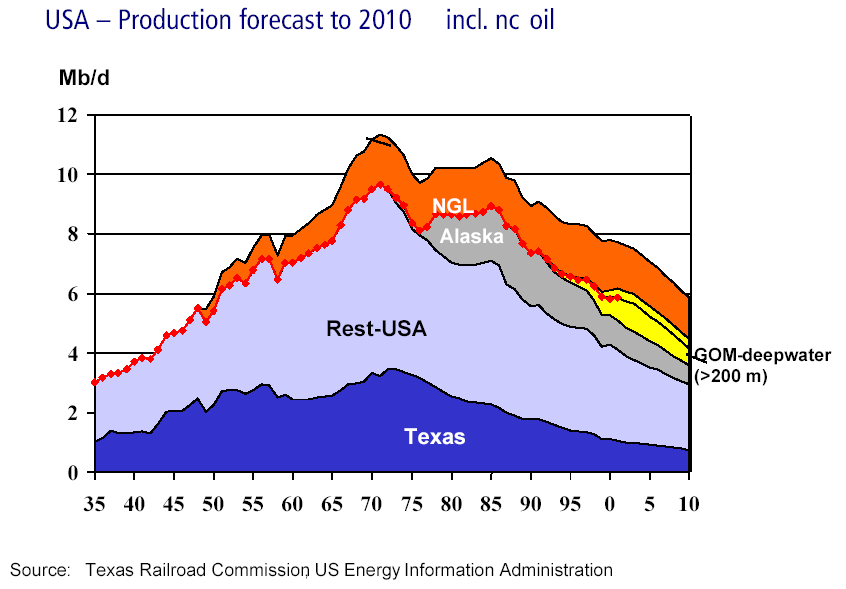
|
It is a fact that peak production of oil will occur. Many place that peak before 2010, while some place it before 2020. The largest point of disagreement is how much oil lies in reserve in the Persian Gulf. This section reviews the past history and current projections of oil production.
This section is based on the paper ``Future World Oil Supply'' by Werner Zittel and Jörg Schindler [14]. The first observation (Figure 1) is that non-OPEC production outside the former Soviet Union is now facing a steep decline. This decline mirrors the historical decline of oil production in the United States, the world's largest oil producer of the 1950s and 1960s (Figure 2).

|

|
The decline is too large for the Persian Gulf producers to make up on a sustained basis. Alaska and the North Sea, the two largest oil discoveries since the energy crises of the 1970s, illustrate the point.
Second, observe the three phases: rise, plateau and fall for different oil regions. The north slope of Alaska and the North Sea were two of the largest fields to be discovered outside of OPEC since 1950. In Figures 3 and 4, we see the typical rise and fall of an oil region. Note how the largest oil fields of a region tend to be discovered and exploited first, followed by successively smaller oil fields. Note also that thirty years of continuously improving technology was unable to prevent the decline of these oil fields.

|

|
Another hope for more oil is non-conventional oil. Non-conventional oil must be processed to be converted into an equivalent of crude oil. Tar Sands (see Section 3.1) are an example of a non-conventional oil. Canada, with 85% of the world's tar sands, is the world's largest producer of non-conventional oil (Figure 5).

|
We have now considered all sources of oil outside of OPEC and outside of the former Soviet Union. Figure 6 shows the total world production when these two last sources of oil are included. (Indonesia was excluded from OPEC for these purposes, since its oil production has long been declining.) Most people think that Saudi Arabia is the only country with major spare capacity. With the non-OPEC countries rapidly losing capacity, it is unlikely that Saudi Arabia alone can make up the difference.

|
There are many free sources of oil statistics for further details [15,16]. In reading the statistics, it is important to distinguish between ``oil'' and ``crude oil''.
Definitions: Crude oil is traditional oil that is pumped from the ground and sent to a refinery. The term oil includes both crude and some non-conventional oils that must be processed or upgraded before being refined. Example of non-crude oil are tar sands, shale oil, ultra-heavy oil, and natural gas liquids (a byproduct of natural gas extraction and processing). The first three exmaples are often called synthetic crude or syncrude. For most countries, most of the oil produced is crude oil. Some exceptions are Canada (tar sands), United States (natural gas liquids) and Venezuela (ultra-heavy oil). However, even there, crude oil is a large majority of the oil produced.